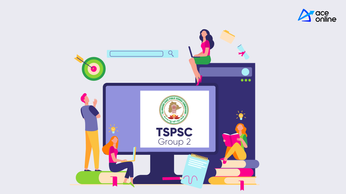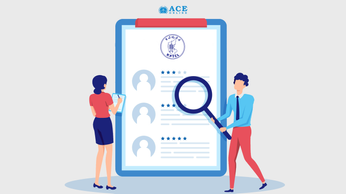SSC CGL, Staff Selection Commission Combined Graduate Level exam is conducted for a frequency of one year to hire the Grade "B" and Grade "C" category jobs in various Government departments, Ministries, Divisions and Offices.
Tiers in SSC CGL Exam
SSC CGL exam is going to be conducted in four phases in which there are Tier-1 and Tier-2 are Online assessments and the other two are Offline Assessment. The SSC CGL exam application is to be done on Online.
- SSC CGL Tier -1
- SSC CGL Tier - 2
- SSC CGL Tier -3
- SSC CGL Tier - 4
SSC CGL Eligibility
To apply for SSC CGL the candidate must have a Bachelor's Degree in any discipline from a recognized University or equivalent.
SSC CGL Age Limit Guidelines
A person must be between the 18-30 years
SSC CGL Exam Pattern
SSC CGL is a four tier exam in two modes as below.
Tier – I | Objective Multiple Choice - Computer-Based Examination (online) |
Tier – II | Objective Multiple Choice - Computer-Based Examination (online) |
Tier – III | Descriptive Paper in English/Hindi Pen and Paper mode |
Tier – IV | Skill Test/Computer Proficiency Test Computer-Based (if applicable) |
SSC CGL Tier - 1 Exam Pattern
Subject | Marks | Questions | Time |
General Intelligence and Reasoning |
25 Questions
50 Marks
|
1 hour
|
General Awareness |
English Comprehension |
Quantitative Aptitude |
SSC CGL Tier - 2 Exam Pattern
Subject | Marks | Questions | Time |
Quantitative Ability |
25 Questions
50 Marks |
2 hours
|
General Studies (Finance and Economics) |
Statistics |
English Language and Comprehension | 200 Questions
100 Marks |
SSC CGL Tier III Exam Pattern
Descriptive Paper in English/Hindi (Writing of Essay, Precis, Letter, Application etc.) | 100 marks
| 2 hours |
SSC CGL Tier IV Exam Pattern
Common Proficiency Test CPT | Windows Office Suit Testing |
Data Entry Skill Test | Need to type 2000 words in 15 minutes |
SSC CGL Exam Syllabus
SSC CGL Tier I Exam Syllabus
Paper | Syllabus |
General intelligence and Reasoning (50 Marks)
| Analogies Similarities and differences Space visualization Spatial orientation Problem solving Analysis Judgment Decision making Visual memory Discrimination Observation Relationship concepts Arithmetical reasoning and figural classification Arithmetic number series Non-verbal series Coding and decoding Statement conclusion Syllogistic reasoning etc Semantic analogy Symbolic/ Number Analogy Figural analogy Semantic classification Symbolic/ number classification Figural classification Semantic series Number series Figural series Word building Coding and decoding Numerical operations Symbolic operations Trends Space orientation Venn diagrams Drawing inferences Punched hole/ pattern-folding and unfolding Figural pattern-folding and completion Indexing Address matching Date and city matching Classification of center codes/ roll numbers Small and capital letters/ numbers coding Decoding and classification Embedded figures Critical thinking Emotional intelligence Social intelligence
|
General awareness (50 Marks) |
General Awareness of the Environment and its Application to Society Knowledge of current events and of such matters of every day observations, and experience in their scientific aspect India and its neighboring countries especially pertaining history, culture, geography, economic scene, general policy and scientific research.
|
Quantitative aptitude (50 Marks) | Computation of whole numbers Decimals Fractions and relationships between numbers Percentage Ratio and proportion Square roots Averages Interest Profit and loss Discount Partnership business Mixture and alligation Time and distance Time and work Basic algebraic identities of school algebra and elementary surds Graphs of linear equations Triangle and its various kinds of centers Congruence and similarity of triangles Circle and its chords Tangents Angles subtended by chords of a circle Common tangents to two or more circles Triangle Quadrilaterals Regular polygons Circle Right prism Right circular cone Right circular cylinder Sphere Hemispheres Rectangular parallelepiped Regular right pyramid with triangular or square base Trigonometric ratio Degree and radian measures Standard identities Complementary angles Heights and distances Histogram Frequency polygon Bar diagram and pie chart
|
English comprehension (50 Marks) | |
Get best exaplanation on all the above concepts by experts through Best Online Coaching for GATE
SSC CGL Tier II Exam Syllabus
Paper | Syllabus |
Quantitative Aptitude | Frequency polygon Sphere Time and distance Tangents Fractions and relationships between numbers Quadrilaterals Bar diagram & Pie chart Hemispheres Time & Work Interest Percentage Regular Polygons Regular Right Pyramid with triangular or square base Rectangular Parallelepiped Elementary surds Profit and Loss Ratio & Proportion Square roots Trigonometric ratio Complementary angles Right Prism Discount Graphs of Linear Equations Averages Degree and Radian Measures Heights and Distances Right Circular Cone Partnership Business Triangle Computation of whole numbers Standard Identities Histogram Right Circular Cylinder Mixture and Alligation Circle and its chords Decimals
|
English Language & Comprehension | Active/ passive voice of verbs Spelling/ detecting misspelled words Spot the error Conversion into direct/ indirect narration Idioms & phrases Fill in the blanks Shuffling of sentence parts One-word substitution Synonyms Shuffling of sentences in a passage of sentences Antonyms Cloze passage Sentence Structure Comprehension passage
|
Statistics (Junior Statistical Officer) | Collection, Classification, and Presentation of Statistical Data Primary and Secondary data Methods of data collection Tabulation of data Graphs and charts Frequency distributions Diagrammatic presentation of frequency distributions
Measures of Central Tendency Measures of Dispersion Moments, Skewness and Kurtosi Different types of moments and their relationship Meaning of skewness and kurtosis Different measures of skewness and kurtosis.
Correlation and Regression Scatter diagram Simple correlation coefficient Simple regression lines Spearman's rank correlation Measures of association of attributes Multiple regression Multiple and partial correlation
Probability Theory Random Variable and Probability Distributions Random variable Probability functions Expectation and Variance of a random variable Higher moments of a random variable Binomial, Poisson, Normal and Exponential distributions Joint distribution of two random variables (discrete).
Sampling Theory Concept of population and sample Parameter and statistic, Sampling and non-sampling errors Probability and nonprobability sampling techniques(simple random sampling, stratified sampling, multistage sampling, multiphase sampling, cluster sampling, systematic sampling, purposive sampling, convenience sampling and quota sampling) Sampling distribution(statement only); Sample size decisions.
Statistical Inference Point estimation and interval estimation Properties of a good estimator Methods of estimation (Moments method, Maximum likelihood method, Least squares method) Testing of hypothesis Basic concept of testing Small sample and large sample tests Tests based on Z, t, Chi-square and F statistic, Confidence intervals
Analysis of Variance Time Series Analysis Index Numbers Meaning of Index Numbers Problems in the construction of index numbers Types of index number Different formulae Base shifting and splicing of index numbers Cost of living Index Numbers Uses of Index Numbers
|
General Studies-Finance and Economics (Assistant Audit Officer/ Assistant Accounts Officer) | Part A: Fundamental principles and basic concept of Accounting - (80 Marks) Financial Accounting: Nature and scope, Limitations of Financial Accounting, Basic concepts and Conventions Generally Accepted Accounting Principles. Basic concepts of accounting: Single and double entry, Books of original Entry, Bank Reconciliation, Journal, ledgers, Trial Balance, Rectification of Errors, Manufacturing, Trading, Profit & loss Appropriation Accounts, Balance Sheet Distinction between Capital and Revenue Expenditure, Depreciation Accounting, Valuation of Inventories, Non-profit organizations Accounts, Receipts and Payments and Income & Expenditure Accounts, Bills of Exchange, Self Balancing Ledgers
Part B: Economics and Governance - (120 marks) Comptroller & Auditor General of India - Constitutional provisions, Role and responsibility Finance Commission - Role and functions Basic Concept of Economics and introduction to Microeconomics - Definition, scope and nature of Economics, Methods of economic study and Central problems of an economy and Production possibilities curve Theory of Demand and Supply - Meaning and determinants of demand, Law of demand and Elasticity of demand, Price, income and cross elasticity; Theory of consumer's behavior Marshallian approach and Indifference curve approach, Meaning and determinants of supply, Law of supply and Elasticity of Supply. Theory of Production and cost - Meaning and Factors of production; Laws of production- Law of variable proportions and Laws of returns to scale. Forms of Market and price determination in different markets - Various forms of markets - Perfect Competition, Monopoly, Monopolistic Competition and Oligopoly ad Price determination in these markets Indian Economy - Nature of the Indian Economy Role of different sectors role of Agriculture, Industry and Services-their problems and growth; National Income of India-Concepts of national income, Different methods of measuring national income. Population-Its size, rate of growth and its implication on economic growth. Poverty and unemployment- Absolute and relative poverty, types, causes and incidence of unemployment. Infrastructure-Energy, Transportation, Communication. Economic Reforms in India - Economic reforms since 1991; Liberalization, Privatization, Globalization and Disinvestment. Money and Banking - Monetary/ Fiscal policy- Role and functions of Reserve Bank of India; functions of commercial Banks/RRB/Payment Banks. Budget and Fiscal deficits and Balance of payments. Fiscal Responsibility and Budget Management Act, 2003
|
SSC CGL Tier III Exam Syllabus
SSC CGL Tier -III is a Descriptive Exam held in English/Hindi to test the candidates knowledge in Writing of Essay, Precis, Letters, Applications etc.
SSC CGL Tier IV Exam Syllabus
SSC CGL Tier - IV consists of two type of Tests namely:
- Date Entry Skill Test (DEST)
- Computer proficiency test (CPT)
- Spreadsheet
- Generation of slides
- Word processing
Enroll for Best Coaching for GATE and successfully crack the SSC exam
SSC CGL Question Papers
SSC CGL 2021 Question Papers
SSC CGL 2020 Question Papers
SSC CGL Hindi Question Papers
SSC CGL Question Paper 13 August 2021 1st Shift in Hindi
SSC CGL Question Paper 13 August 2021 2nd Shift in Hindi
SSC CGL Question Paper 13 August 2021 3rd Shift in Hindi
SSC CGL Question Paper 16 August 2021 All Shift in Hindi
SSC CGL Question Paper 17 August 2021 All Shift in Hindi
SSC CGL Question Paper 18 August 2021 All Shift in Hindi
SSC CGL Question Paper 20 August 2021 All Shift in Hindi
SSC CGL Question Paper 23 August 2021 All Shift in Hindi
SSC CGL Question Paper 24 August 2021 All Shift in Hindi
Subscribe our YouTube Channel for more updates https://bit.ly/3I1PDWs
For simple and smooth learning follow us on Facebook https://bit.ly/3uUG47W
Easy to learn, simple to remember follow us on Instagram https://bit.ly/3oTntVU
Download our android app to receive updates https://bit.ly/3HY20CS
Connect with knowledge - To Download our windows app https://bit.ly/3LGyVOg
Think bigger, Learn Smarter, Download our iOS app https://apple.co/3LFzwzO







